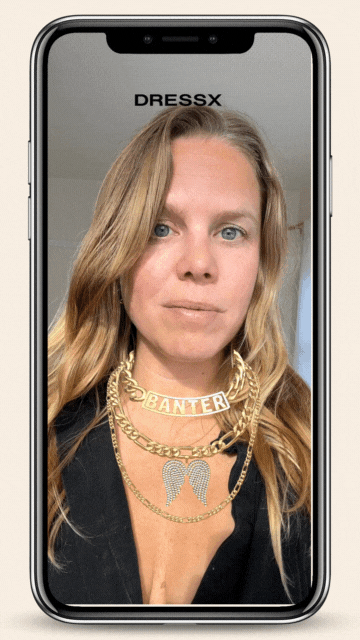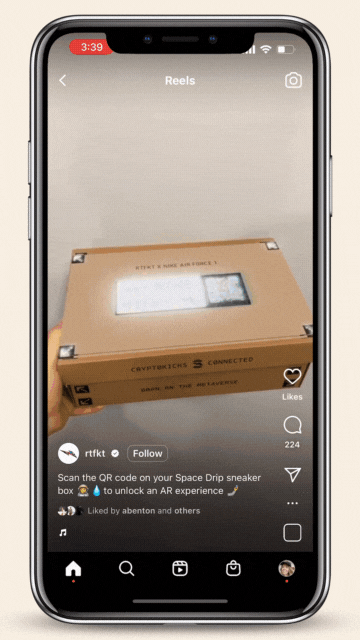WHAT IS THE METAVERSE, REALLY & WHERE IS IT HEADED?
The Metaverse: we’ve all heard about it even if we don’t really understand it. Over the last two years, the “Metaverse” has been a catchall term for hard-to-explain visions of the new digital age, one associated with headsets and virtual worlds, new tokens, artificial intelligence, blockchain, biometric security, haptics, cryptography, augmented reality, and games.
It’s mind-bending on a good day, but it’s worth paying attention. Like the Internet 25 years ago, the Metaverse will disrupt most aspects of the consumer experience. As real and virtual worlds converge, the way consumers think about self-expression, community, experiences, and ownership is fundamentally changing.
The Business of Fashion 2022 report highlights how momentum is building:
Fashion companies focused on metaverse innovation and commercialisation could generate more than 5 percent of revenues from virtual activities over the next two to five years. Global spending on virtual goods reached an estimated $110 billion in 2021, more than doubling the total in 2015, with around 30 percent attributed to virtual fashion.
Just like the Internet in the 90s, this recent boom-bust cycle is a hallmark sign that innovation is in full-swing and the future of consumer behavior, and all the market share that goes with it, is being mapped and built today.
WHAT IS THE METAVERSE, REALLY
WHAT IS THE METAVERSE TODAY?
At the most basic level, the metaverse is a new way for consumers to spend time.
In the near future, an ecosystem of technologies and spaces like virtual worlds, blockchain, AR/VR/XR, NFTs, and gaming, will begin to intersect with everyday life, forever changing how we work, play connect, transact, and more.
THE METAVERSE IS A VISION, NOT A DESTINATION.
The Metaverse and Web3, which are often synonymous, speak to a diverse set of technologies that will usher in the next era of digital innovation. Like the Internet, the Metaverse is not one discrete thing, but a network of many things.
To some, “The Metaverse” implies a specific vision for the future, one where consumers will visit interconnected virtual worlds to explore, shop, connect, date, etc., whereas “Web3” refers to the vast suite of technologies that will support that vision (and more).
To reduce confusion, we will use these terms as synonyms in these essays.
Most importantly, the Metaverse of the future has not arrived yet, it is being imagined now. The opportunity to influence the next decade of consumer behavior is happening today and there’s never been a more primed moment to start experimenting, building, and scaling.
THE METAVERSE IS A UNIVERSE OF EMERGING TECHNOLOGY, WE FOCUS ON TWO MAJOR ECOSYSTEMS.
Of all the technologies and industries related to metaverse innovation, we focus first on two big areas of innovation: new layers of commerce and the shift from 2D to 3D experiences.
Zooming way out, vast new ecosystems emerge around these two major themes:
New mechanisms of value, ownership, commerce, & security via blockchain technology
Transformation from 2D to 3D experiences
These two themes collide to create metaverses: immersive, virtual worlds (2D-3D) where people can shop, play, create, exchange, and more (blockchain-enabled value or ownership).
WHERE IS IT GOING?
THE METAVERSE & WEB3 WILL TRANSFORM THE INTERNET FROM A 2D TO 3D EXPERIENCE.
Today, our “Web2” world is in 2D- flat images, banner ads, reels, video- all the content we scroll through daily. Even if the media captures rich dimension, like videos, our experience of that content is in 2D, often viewed through some sort of box - a smart phone, computer, TV, movie screen.
By contrast, the Web3 world is moving to 3D, promising that tomorrow we will have the option to interact or be immersed in these experiences. How? Using technology like Augmented Reality (AR) and Virtual Reality (VR).
In AR, images render in 3D to augment the reality around us. Although still trapped in a phone or computer, the images appear like objects, meaning we can mix our physical and digital realities through our device. AR is already impacting our everyday experience. Today, people can digitally try-on clothes/ shoes/ jewelry, place objects like furniture in spaces, see how pieces of a machine fit together, and so much more.
If AR blends the physical and digital worlds, then Virtual Reality is the experience of being placed into a different world using a headset or similar device. In short, the device takes over your field of vision, shifting your perception of 3D reality from the physical world to a digital one. Using a headset, like Oculus or Quest, participants are transported to vast worlds, experiences, and games where the imagery looks real with shadows, dimension, and movement.
We will do a deeper dive on the impact on both of these tools in our next essays, don’t miss it.
WE’RE MOVING FROM A COMMUNICATIONS TO EXPERIENCES PARADIGM.
As we’ve outlined above, moving from 2D to 3D opens the aperture for how we experience the world. In this shift, consumer brands gain renewed power to tell stories and incentivize customers. Communication paradigms rely on pulsing out information through distribution platforms, which over the last century evolved rapidly from telegrams and newspapers to modern-day social media and online streaming. Despite the evolution, the audience has remained passive, meaning consumers absorb or ignore but they do not influence the core message in real time.
So what’s next? In an Experiential paradigm, the audience also becomes the creator. Information is passed back and forth in real time, which influences what is created next. We experience life everyday in the real world, but transitioning that level of immersive interaction into virtual worlds presents a cascade of considerations and challenges.
We’re not there yet, but as we move from a 2D passive feed to an immersive 3D world, the after-effect is less of a ripple and more like tsunami. Tidal shifts will occur across industries, and for Consumer markets like retail, fashion, lifestyle, and CPG, a new era of Marketing is rapidly approaching to meet the interactive future. There’s never been a more exciting time to reimagine Brand and Marketing Strategies.
THANKS TO AVATARS, SELF-EXPRESSION WILL BE REIMAGINED, EXPANDED, & MULTIPLIED.
As we begin to experience more mixed reality and virtual worlds, Avatars increasingly become the face of our digital identities. Without the limits of one physical body, any one person can create multiple avatars to represent a mood, attitude, season, and beyond- the list is endless.
Similarly, without the constraints of the physical world, the tools of self-expression will be reimagined and expanded. As humans, we use the material world to signal status, culture, belonging, personality, style and so much more. This will still very much exist.
Simultaneously, we will expand self-expression into more digital spaces, unleashing creativity as consumers crave new tools and codes for self-expression. We’re just beginning to see the possibilities with avatars, gaming skins, digital fashion, and NFTs. Entire categories will be reimagined and invented as we play with new virtual environments, free of constraints like materials, supply chain, and weight.
New forms of art, style, fashion, brands, celebrities, and more will take shape as digital culture evolves.
NFTS WILL GO MAINSTREAM AS A FOUNDATIONAL TOOL FOR OWNERSHIP.
NFTs may be on the decline in 2023, but they are fundamental tool that will disrupt how customers think about ownership and rewards. Quickly, this new system will disrupt transactional loyalty (Web2), ushering in a new vision for Community ROI, incentives, and long-term value.
In the near term, NFTs will be used like a new membership card, but with supercharged access and capabilities.



